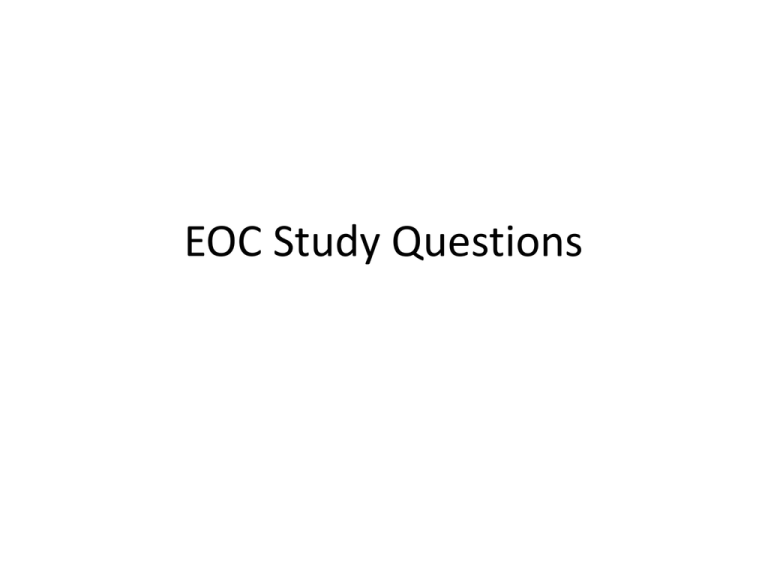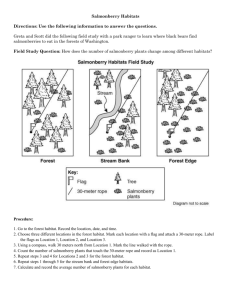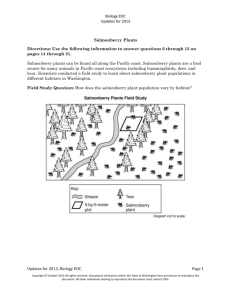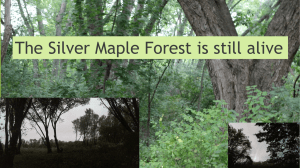
EOC Study Questions
• 1 Coyotes eat proteins in food. The proteins
break down due to enzymes produced in the
stomach of the coyote. The production of
these enzymes then causes more enzymes to
be released in the stomach. Which process
does this describe?
• o A. Meiosis
• o B. Diffusion
• o C. Feedback
• o D. Respiration
• 2 What is one purpose of ATP molecules in
plant and animal cells?
• o A. To increase the rate of diffusion across
cell membranes
• o B. To decrease the rate of chemical reactions
• o C. To store energy used for cell processes
• o D. To pass genetic traits to offspring
• 3 A strand of DNA contains the
sequence GGC-CAT. What is the
complementary strand of mRNA for
this sequence?
• Write your answer in the box.
CCG-GUA
• 4 Which scientific evidence would show that
two species of birds are closely related?
• o A. The two bird species have similar DNA
sequences
• o B. The two bird species eat many of the
same insects
• o C. The two bird species are found in the
same area
• o D. The two bird species have similar feather
colors
• 1 How is cellular respiration by plants
similar to the burning of fossil fuels?
• o A. Both release oxygen for
organisms that are consumers.
• o B. Both break down carboncontaining compounds.
• o C. Both produce ATP.
• o D. Both absorb light.
• 2 Which process increases genetic
variation among whale offspring?
• o A. Division of cells in mitosis
• o B. Fertilization of egg cells
• o C. Synthesis of proteins
• o D. Assembly of lipids
• 3 Adding habitat is a solution to the problem of
decreased butterfly populations in prairie
• ecosystems. What could be an unintended
consequence of adding habitat
• for butterflies?
• o A. Beneficial nutrients could be removed from
the ecosystem.
• o B. The air temperature could increase in the
ecosystem.
• o C. Materials new to the ecosystem could be
introduced.
• o D. The amount of light in the ecosystem could
increase.
• 4 In mammals, the hormone insulin helps
decrease the amount of glucose in blood.
• Which describes a negative feedback system
between insulin and glucose?
• o A. Small amounts of glucose in blood keep
insulin from working properly.
• o B. Insulin is constantly released to prevent low
glucose levels in blood.
• o C. Insulin causes the addition of large amounts
of glucose to blood.
• o D. High levels of insulin decrease blood glucose
levels.
• 5 Months after a forest fire, some nonnative
plants began to grow in the area. Why were
• these plants able to grow?
• o A. The plants were able to survive without
water.
• o B. The plants were able to use the ash as
chemical energy.
• o C. The plants were able to thrive in the
newly formed niches.
• o D. The plants were able to mutate to adjust
to the new surface materials.
• Directions: Use the following information to
answer questions 6 through 15 on
• pages 14 through 21.
• Salmonberry plants can be found all along the
Pacific coast. Salmonberry plants are a food
• source for many animals in Pacific coast
ecosystems including hummingbirds, deer, and
• bear. Scientists conducted a field study to learn
about salmonberry plant populations in
• different habitats in Washington.
• Field Study Question: How does the salmonberry
plant population vary by habitat?
• Procedure:
• 1. Go to the salmonberry field study area. Record location, date,
time, and temperature.
• 2. Choose a random location in the forest edge habitat.
• 3. Measure a 5-meter-by-5-meter plot and label as Plot 1.
• 4. Count the number of salmonberry plants in Plot 1. Record as Plot
1 for the forest edge habitat.
• 5. Repeat steps 2 through 4 for Plot 2 and Plot 3, choosing a new
location in the forest edge habitat for each plot.
• 6. Repeat steps 1 through 5 for the stream bank and forest habitats.
• 7. Calculate and record the average number of salmonberry plants
for each habitat.
• Data Collected:
• Location: Forest edge, stream bank, and forest habitats
• Date and Time: May 1, from 11:00 A.M. to 2:00 P.M.
• Temperature: 10° C to 15° C
• 6 How could the validity of this field study be
improved?
• o A. Use a fourth habitat type in the field
study.
• o B. Count the number of trees in the field
study area.
• o C. Use three 1-meter-by-1-meter plots in
each habitat.
• o D. Count the salmonberry plants in four
plots at each habitat.
• 7 Which output from bears is used by
salmonberry plants?
• o A. Carbon dioxide from bears is used for
photosynthesis in plants.
• o B. Oxygen from bears is used for
photosynthesis in plants.
• o C. Glucose from bears is used for respiration
in plants.
• o D. Water from bears is used for respiration
in plants.
• 9 Blackberry plants are found in forest edge
habitats. How could blackberry plants limit the
population of salmonberry plants?
• o A. Blackberry plants increase oxygen in the
ecosystem.
• o B. Blackberry plants lack flowers that attract
bees.
• o C. Blackberry plants produce dark purple
berries.
• o D. Blackberry plants compete for resources.
• 10 Salmonberry leaf cells contain 14
chromosomes. How many chromosomes will a
new leaf cell contain after mitosis?
• Write your answer in the box.
14
• ____________________
chromosomes
• 11 Some bears are getting into trash cans at
campgrounds near the forest. The park
• rangers plan to trap and relocate these bears to solve
the problem of these bears getting
• into the trash. Describe two constraints other than cost
that park rangers could
• encounter while trapping and relocating these bears.
• In your description, be sure to:
• Identify two constraints on trapping and relocating
these bears other than cost.
• Describe how each constraint is a limitation.
• One constraint:
• Another constraint:
• 12 Which event might be evidence that the
forest edge habitat is in equilibrium?
• o A. A dead tree providing nutrients for a
young tree
• o B. A bird species leaving as temperatures
increase
• o C. A landslide damming the stream in the
habitat
• o D. A flood washing away topsoil from the
ground
• 13 Salmonberry plant roots absorb minerals.
What cellular process moves minerals across
• root cell membranes from an area of low
mineral concentration to an area of high
• mineral concentration?
• o A. Facilitated diffusion
• o B. Passive transport
• o C. Active transport
• o D. Osmosis
• 14 Scientists wondered how the presence of the new type
of grass could affect the
• population of salmonberry plants in a forest ecosystem.
What kind of investigation
• would be most appropriate to answer this question?
• o A. A field study because factors that are hard to control
could influence
• the results
• o B. A research paper because information is available
about many kinds
• of plants
• o C. A controlled experiment because all the variables can
be kept the same
• o D. A simulation because computers are more reliable
than natural systems
Additional Information…
• MITosis = Make It Two
• One parent cell divides into 2 identical daughter
cells
• Parent cell and daughter cells have the same
number of chromosomes
• Parent and daughter cells have same genetic
information
• Process is needed for growth and
repair/replacement
• Mitosis happens in somatic cells (body cells)
Additional Information…
• mEiosis = sEx
• One parent cell divides into 4 daughter cells (gametes)
• Each daughter cell has a unique combination of alleles
due to crossing-over and Independent Assortment
• daughter cells have HALF the number of chromosomes
as the parent cell
• Process is needed for sexual reproduction (so that
when fertilization occurs, the zygote has the correct
number of chromosomes)
• Meiosis occurs in sex cells only.












